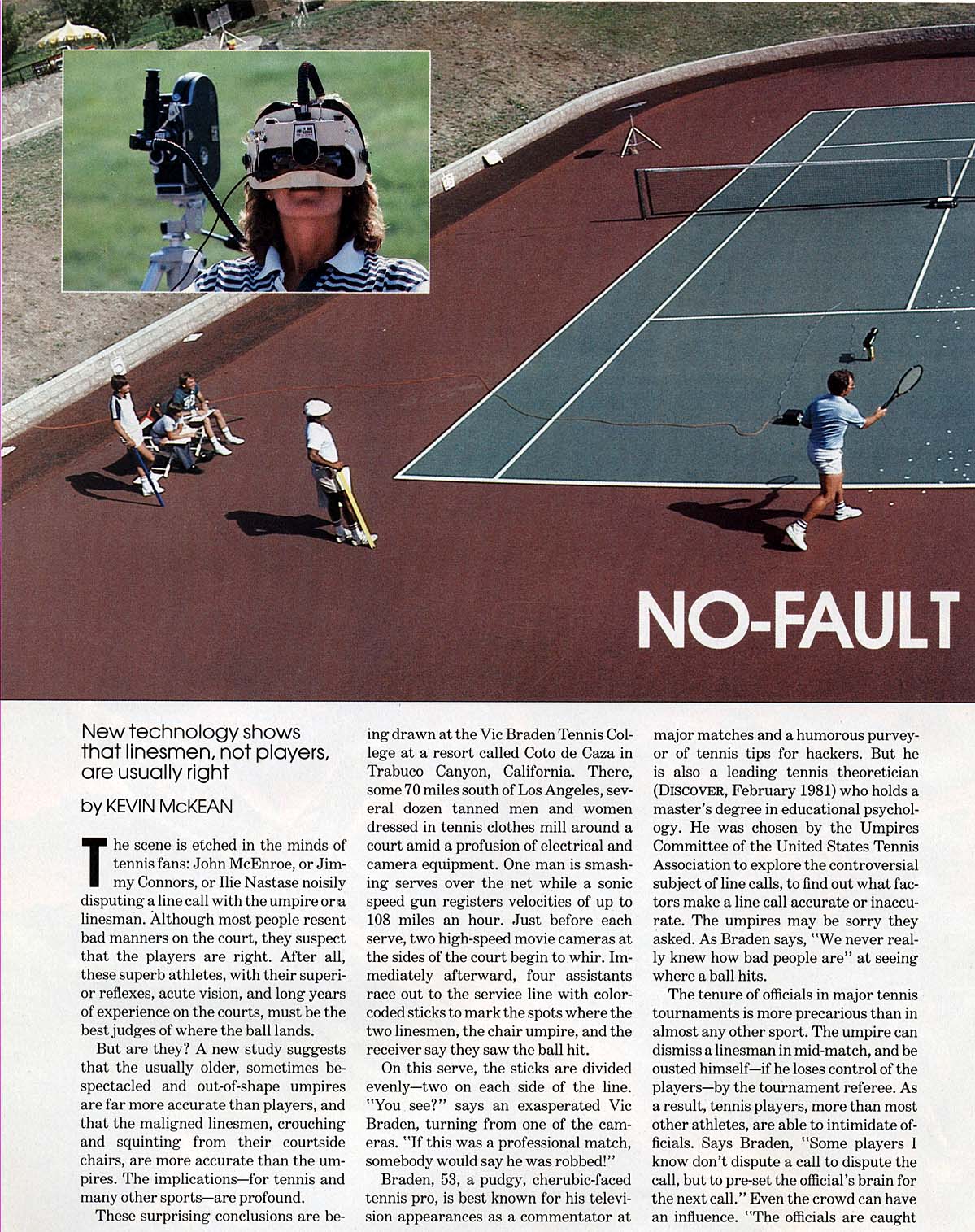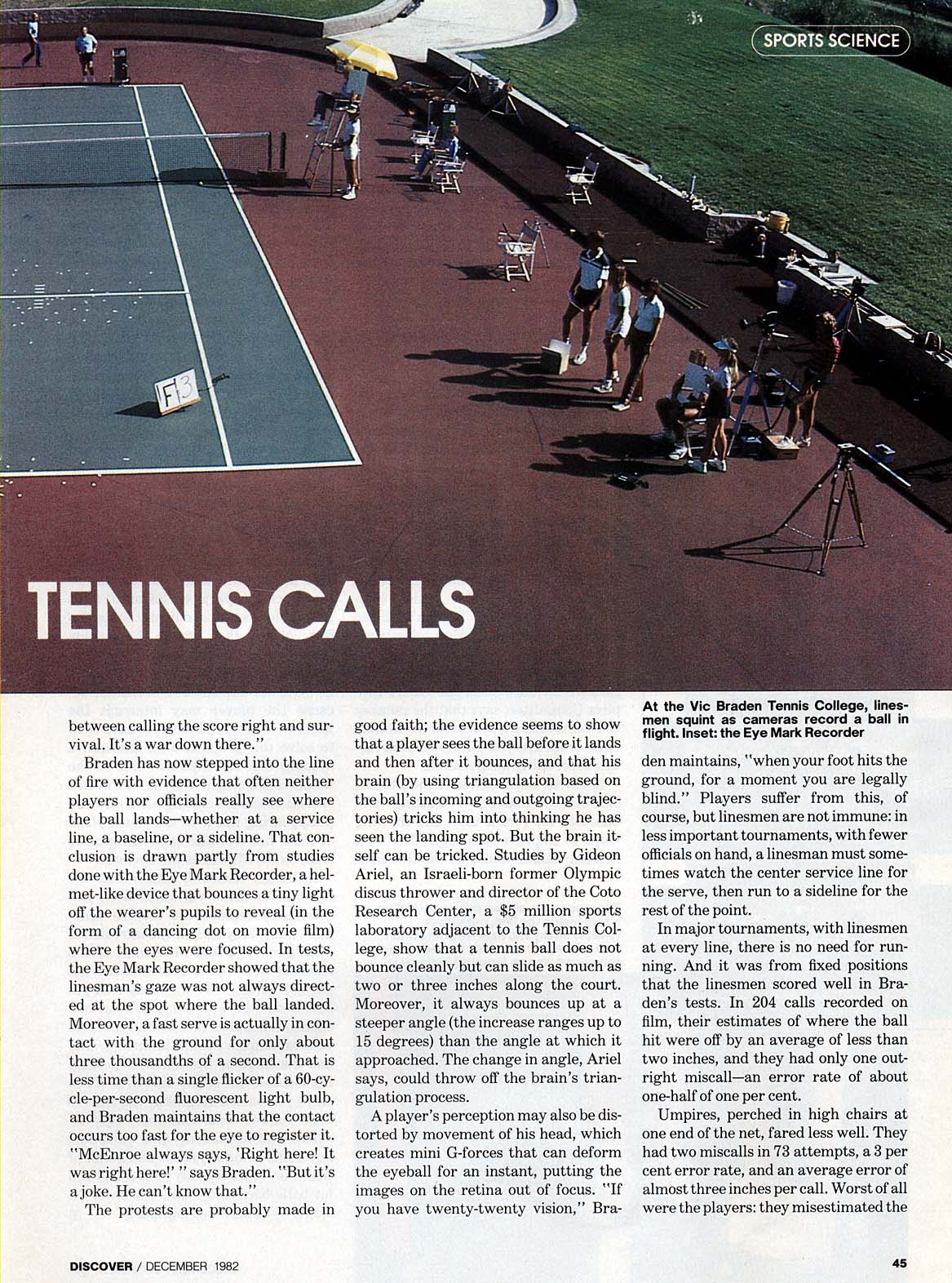No Fault Tennis Calls
New technology shows that linesmen, not players, are usually right
By Kevin McKean in Discover on Wednesday, December 1, 1982
This article by Kevin McKean discusses a study conducted at the Vic Braden Tennis College, which suggests that linesmen and umpires are more accurate in their calls than tennis players. The study used high-speed cameras and the Eye Mark Recorder, a device that tracks eye movement, to analyze the accuracy of line calls. The results showed that linesmen were off by less than two inches on average, while players misestimated the point of impact by an average of five inches. The study also revealed that the human eye struggles to accurately register the exact point of contact when a tennis ball hits the ground due to the speed of the game. The findings challenge the common perception that players, with their superior reflexes and experience, are the best judges of where the ball lands.
Tip: use the left and right arrow keys
New technology shows that linesmen, not players, are usually right
by KEVIN McKEAN
The scene is etched in the minds of tennis fans: John McEnroe, or Jimmy Connors, or Ilie Nastase noisily disputing a line call with the umpire or a linesman. Although most people resent bad manners on the court, they suspect that the players are right. After all, these superb athletes, with their superior reflexes, acute vision, and long years of experience on the courts, must be the best judges of where the ball lands.
But are they? A new study suggests that the usually older, sometimes bespectacled and out-of-shape umpires are far more accurate than players, and that the maligned linesmen, crouching and squinting from their courtside chairs, are more accurate than the umpires. The implications-for tennis and many other sports-are profound.
These surprising conclusions are being drawn at the Vic Braden Tennis College at a resort called Coto de Caza in Trabuco Canyon, California. There, some 70 miles south of Los Angeles, several dozen tanned men and women dressed in tennis clothes mill around a court amid a profusion of electrical and camera equipment. One man is smashing serves over the net while a sonic speed gun registers velocities of up to 108 miles an hour. Just before each serve, two high-speed movie cameras at the sides of the court begin to whir. Immediately afterward, four assistants race out to the service line with colorcoded sticks to mark the spots where the two linesmen, the chair umpire, and the receiver say they saw the ball hit.
On this serve, the sticks are divided evenly-two on each side of the line. "You see?" says an exasperated Vic Braden, turning from one of the cameras. "If this was a professional match, somebody would say he was robbed!"
Braden, 53, a pudgy, cherubic-faced tennis pro, is best known for his television appearances as a commentator at major matches and a humorous purveyor of tennis tips for hackers. But he is also a leading tennis theoretician (DISCOVER, February 1981) who holds a master's degree in educational psychology. He was chosen by the Umpires Committee of the United States Tennis Association to explore the controversial subject of line calls, to find out what factors make a line call accurate or inaccurate. The umpires may be sorry they asked. As Braden says, "We never really knew how bad people are" at seeing where a ball hits.
The tenure of officials in major tennis tournaments is more precarious than in almost any other sport. The umpire can dismiss a linesman in mid-match, and be ousted himself'-if he loses control of the players-by the tournament referee. As a result, tennis players, more than most other athletes, are able to intimidate officials. Says Braden, "Some players I know don't dispute a call to dispute the call, but to pre-set the official's brain for the next call." Even the crowd can have an influence. "The officials are caught between calling the score right and survival. It's a war down there."
Braden has now stepped into the line of fire with evidence that often neither players nor officials really see where the ball lands-whether at a service line, a baseline, or a sideline. That conclusion is drawn partly from studies done with the Eye Mark Recorder, a helmet-like device that bounces a tiny light off the wearer's pupils to reveal (in the form of a dancing dot on movie film) where the eyes were focused. In tests, the Eye Mark Recorder showed that the linesman's gaze was not always directed at the spot where the ball landed. Moreover, a fast serve is actually in contact with the ground for only about three thousandths of a second. That is less time than a single flicker of a 60-cycle-per-second fluorescent light bulb, and Braden maintains that the contact occurs too fast for the eye to register it. "McEnroe always says, 'Right here! It was right here!' " says Braden. "But it's a joke. He can't know that."
The protests are probably made in good faith; the evidence seems to show that a player sees the ball before it lands and then after it bounces, and that his brain (by using triangulation based on the ball's incoming and outgoing trajectories) tricks him into thinking he has seen the landing spot. But the brain itself' can be tricked. Studies by Gideon Ariel, an Israeli-born former Olympic discus thrower and director of the Coto Research Center, a $5 million sports laboratory adjacent to the Tennis College, show that a tennis ball does not bounce cleanly but can slide as much as two or three inches along the court. Moreover, it always bounces up at a steeper angle (the increase ranges up to 15 degrees) than the angle at which it approached. The change in angle, Ariel says, could throw off the brain's triangulation process.
A player's perception may also be distorted by movement of his head, which creates mini G-forces that can deform the eyeball for an instant, putting the images on the retina out of focus. "If' you have twenty-twenty vision," Braden maintains, "when your foot hits the ground, for a moment you are legally blind." Players suffer from this, of course, but linesmen are not immune: in less important tournaments, with fewer officials on hand, a linesman must sometimes watch the center service line for the serve, then run to a sideline for the rest of the point.
At the Vic Braden Tennis College, lines men squint as cameras record a ball in flight. Inset: the Eye Mark Recorder
In major tournaments, with linesmen at every line, there is no need for running. And it was from fixed positions that the linesmen scored well in Braden's tests. In 204 calls recorded on film, their estimates of where the ball hit were off by an average of less than two inches, and they had only one outright miscall-an error rate of about one-half of one per cent.
Umpires, perched in high chairs at one end of the net, fared less well. They had two miscalls in 73 attempts, a 3 per cent error rate, and an average error of almost three inches per call. Worst of all were the players: they misestimated the
SPORTS SCIENCE
point of impact by an average of five inches, had seven miscalls in 63 attempts, for an error rate of 11 per cent, and were unable even to call the ball on ten other occasions because they could not see it. This was especially true on the 100-mile-an-hour serves. Acknowledges tennis coach Will Arias, "I had a feel for whether it was in or out, but I couldn't tell how far. A lot of times it was just, 'Lord, help me get it back.' "
Braden's conclusion that linesmen make the most accurate calls throws doubt on the wisdom of the rule-instituted just three years ago-that allows the chair umpire to reverse a linesman. Ken Farrar, one of five full-time supervisors on the Grand Prix (men's professional) tour, defends the regulation as necessary to keep order. "It's only for obvious mistakes," he says. "We tell umpires it's ludicrous to overrule a ball that's closer than two inches to the line." But Braden points out that the average error of umpires in his studies was greater than two inches. Says he, "There should be no overrules unless the linesman asks for help."
The tennis world first got word of Braden's unsettling findings when he gave a short talk and showed a 20-minute video tape to officials at the U.S. Open in New York City this fall. The linesmen cheered, but some chair umpires were skeptical. "If a man can't see a ball two inches from the line," says Jason Smith, an official at the Open every year since 1959, "he should not be in the tennis business, he should be selling seeing-eye dogs." The critics complained that some of Braden's "linesmen" and "umpires" were not experienced referees, but only coaches from his Tennis College. Nonetheless, Bob Rockwell, chairman of the USTA Umpires Committee, says that the number of overrules at the tournament, already down from last year, declined even further after the Braden session.
Rockwell wants Braden to help tennis officials by making a training film based on his recent tests and showing ways to improve accuracy. One way, Braden thinks, would be for the linesman calling the baseline to watch the flight of the ball long enough to determine about where it will cross the line, then fix his gaze there until the ball hits. This would reduce head movement that could distort the eyeballs.
Braden concedes that his experiments need more data and better controls, but he thinks the results are good enough to show that human error is a significant factor in officiating in tennis-and probably most other sports, too. "The implications are fantastic," he says. "In basketball, the referee is running back and forth the whole game, having the same problem seeing as the players. How about hockey, when the referees are skating at full speed?"
The answer, Braden says, is more and better referee training. But others, including his partner, Gideon Ariel, think that the Coto de Caza studies point up the need for automated equipment, like the electronic serve caller used at Wimbledon and at the U.S. Open since 1980. This instrument, known informally as the Cyclops, projects infrared light beams along and just outside the service line. A ball that breaks the outside beams without breaking the beam along the line is ruled out. But Cyclops is no good for baselines or sidelines, because the player may interrupt the beam with his foot. Inventors have tried to solve this problem with alternative systems that use exposed wires on the tennis court, magnets in the ball, even a special chemical coating that leaves a disappearing mark on the court. None of these has won the same acceptance from tennis officials as the Cyclops.
Although Rockwell thinks that the Cyclops, or some variation of it, will eventually replace the service linesman, many players fear the intrusion of machines. Says Jim McManus, of the Association of Tennis Professionals, the players' union, "We might as well get robots out there to play, and put mechanical clappers in the stands." And veteran umpire Frank Hammond, who had the singular distinction of tossing Ilie Nastase out of the 1979 U.S. Open only to be ousted himself by the tournament referee, feels that unerringly accurate and unchallengeable electronic line callers might just do the game of tennis in. "If everybody just smiled and hit balls back and forth," he says, "it would be a rather boring sport." p
DISCOVER/ DECEMBER 1982
Film sequence shows this serve hitting a foot inside the line, but player yellow stick) and near-side linesman green) said it was out; far-side linesman blue) and umpire (orange) called it in




